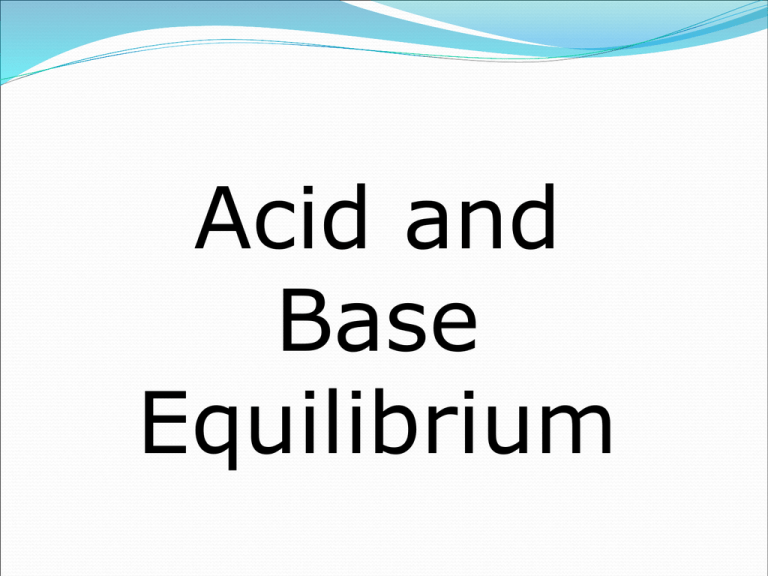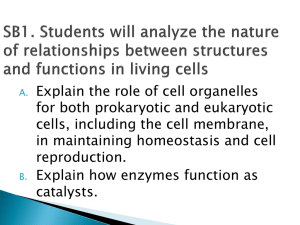Acid-Base Equilibrium: Concepts and Calculations
advertisement

Acid and Base Equilibrium Arrhenius Definition Acids produce hydrogen ions in aqueous solution. (Arhennius definition) Bases produce hydroxide ions when dissolved in water. (Arhennius definition) Limits to aqueous solutions. Only one kind of base. NH3 ammonia could not be an Arrhenius base. Brønsted-Lowry Definitions And acid is an proton (H+1) donor and a base is a proton acceptor. Acids and bases always come in pairs. HCl is an acid. When it dissolves in water it gives its proton to water. HCl(g) + H2O(l) H3O+1 + Cl-1 OR HCl H+1 + Cl-1 Water is a base makes hydronium ion. General Acid/Base Equation The general equation is: HA(aq) + H2O(l) H3O+1(aq) + A-1(aq) Acid + Base Conjugate acid + Conjugate base This is an equilibrium situation. Competition for H+1 between H2O and A-1 The stronger base controls direction. If H2O is a stronger base it takes the H+1 Equilibrium moves to right. Acid dissociation constant Ka The equilibrium constant for the general equation. HA(aq) + H2O(l) H3O+1(aq) + A-1(aq) Ka = [H3O+1][A-1] [HA] H3O+1 is often written H+1 ignoring the water in equation (it is implied). Either way of expressing it is fine. Acid dissociation constant Ka HA(aq) H+1(aq) + A-1(aq) Ka = [H+1][A-1] [HA] We can write the expression for any acid. Strong acids dissociate completely and their equilibrium is far to the right. Conjugate base must be weak. Don’t forget stoichiometry if you have an acid with 2 H+1 ions like H2SO4 A Way to Describe Acids Strong acids Weak acids Ka is large Ka is small [HA] A- is a weaker base than water A- is a stronger [H+] is equal to [H+] <<< [HA] base than water More Ways to Describe Acids Polyprotic Acids- more than 1 acidic hydrogen (diprotic, triprotic). Sulfuric Acid – H2SO4 Oxyacids - Proton is attached to the oxygen of an ion. An example is H3PO4 Phosphoric Acid Organic acids contain the Carboxyl group COOH with the H attached to O. An example of this is Acetic Acid which we call vinegar. Organic Acids are generally very weak. Amphoteric Nature of Water Behaves as both an acid and a base. Water autoionizes as shown below. 2 H2O(l) H3O+1(aq) + OH-1(aq) KW= [H3O+1][OH-1] = [H+1][OH-1] At 25ºC KW = 1.0 x 10-14 In EVERY aqueous solution. Neutral solution [H+1] = [OH-1] = 1.0 x 10-7 Acidic solution [H+1] > [OH-1] Basic solution [H+1] < [OH-1] pH pH= -log[H+1] Used because [H+1] is usually very small. As pH decreases, [H+1] increases exponentially. Log is based on a factor of 10. Only the digits after the decimal place of a pH are significant. [H+1] = 1.0 x 10-8 pH= 8.0 pOH= -log[OH-1] AND pKa = -log Ka Relationships KW = [H+1][OH-1] = 1.0 x10-14 -log KW = -log([H+][OH-]) -log KW = -log[H+]+ -log[OH-] pKW = pH + pOH pH + pOH = 14.00 [H+],[OH-], pH and pOH OR Given any one of these we can find the other three variables. [H+1] 100 10-1 10-3 10-5 10-7 10-9 10-11 10-13 10-14 pH 0 1 Acidic 14 13 10-14 10-13 3 11 5 7 9 Neutral 9 7 5 11 3 13 14 Basic 1 0 pOH 10-11 10-9Basic 10-7 10-5 10-3 10-1 100 [OH-1] Calculating pH of Solutions Always write down the major species in solution. Strong Acids &/or Bases. Water Known Conjugates. Remember these are equilibria. Remember the stoichiometry. Don’t try to memorize there is no one way to do this. Strong Acids HCl, HNO3, H2SO4, HClO4 (HBr, HI) Completely dissociated. Ka is said to be infinite, since there is no reactant left. [H+1] = [HA] [OH-1] is going to be small because of equilibrium and is only present due to the autoionization of water. Weak Acids Ka will be small, often, very small. Determine whether most of the H+1 will come from the acid or the water. You do this by comparing Ka to Kw and see which one has a higher dissociation. The rest of the problem is just like last previous problems. SET UP THE ICE BOX DETERMINE THE SHIFT If [HA]< 10-7 water contributes more H+1 Example of a Ka Problem Calculate the pH of 2.0 M acetic acid HC2H3O2 with a Ka of 1.8 x 10-5 Calculate pOH, [OH-1], [H+1] HC2H3O2 H+1 + C2H3O2-1 Initial Change Equilibrium 1.8 x 10-5 = x2 / 2 2.0 0 0 -x +x +x 2.0 – x x x x = .006 5% rule works The Complete Solution We found that x = .006 and that this was the amount of [H+1]. Solving for pH gives 2.22 Solving for pOH 14 – 2.22 = 11.78 Solving for [OH-1] [H+1] [OH-1] = 10-14 so [OH-1] = 1.66 x 10-12 It wasn’t asked in this problem, but .006 is also the amount of the acetate ion in solution. A mixture of Weak Acids Determine the major species. The stronger will dominate. Bigger Ka if concentrations are comparable Calculate the pH of a mixture of 1.20 M HF (Ka = 7.2 x 10-4) and 3.4 M HOC6H5 (Ka = 1.6 x 10-10) The HF is clearly the dominant species as its Ka is 6 factors of 10 higher. Note: Remember that the Ka is a negative exponent. Upon Further Review We can apply some LeChatelier’s Principal Ideas to this problem. 1.20 M HF (Ka = 7.2 x 10-4) and 3.4 M HOC6H5 (Ka = 1.6 x 10-10) From the problem, we see that HOC6H5 is a minor contributor, but if LeChatelier’s Principal is taken into account we see that it is even less than originally thought. The addition of H+1 ions from the HF (the major species) further shift the HOC6H5 dissociation to the left restricting its H+1 contribution. Percent dissociation = amount dissociated x 100 % initial concentration For a weak acid percent dissociation increases as acid becomes more dilute. Calculate the % dissociation of 1.00 M and .00100 M Acetic acid (Ka = 1.8 x 10-5) As [HA]0 decreases [H+1] decreases but % dissociation increases. If you know the dissociation What is the Ka of a weak acid that is 8.1 % dissociated as 0.100 M solution? Still set up the ICE BOX and you know that 8.1 % of the .1 M solution is going to dissociate (x) and that 91.9 % of the solution will remain as a molecule. Bases The OH-1 is a strong base. (Arrhenius) Hydroxides of the alkali metals are strong bases because they dissociate completely when dissolved. The hydroxides of alkaline earths Ca(OH)2 etc. are strong dibasic bases, but they don’t dissolve well in water. Used as antacids because [OH-1] will combine with [H+1] to form water. Bases without OH Bases are proton acceptors. (Brønsted- Lowry) NH3 + H2O NH4+1 + OH-1 It is the lone pair on nitrogen that accepts the proton. Many weak bases contain a Nitrogen atom. B(aq) + H2O(l) BH+1(aq) + OH-1(aq) Kb = [BH+][OH- ] [B] The Law of Mass Action doesn’t change. Strength of Bases Group 1 and 2 hydroxides are strong. Eg. NaOH, KOH, Ca(OH)2 Most others are weak. The smaller the Kb the weaker the base. Calculate the pH of a solution of 4.0 M pyridine (Kb = 1.7 x 10-9) N: Polyprotic acids Always dissociate stepwise, one H+1 at a time. The first H+1 comes off much easier than the second. It’s Ka will always be greater. Ka1 for the first step is much bigger than Ka2 for the second. Denoted Ka1, Ka2, Ka3 to clarify which step is being referred to. Polyprotic acid # 2 H2CO3 H+1 + HCO3-1 Ka1= 4.3 x 10-7 HCO3-1 H+1 + CO3-2 Ka2= 4.3 x 10-10 The base in the first step is often the acid in second. Your Ka values will tell you this. In calculations we can normally ignore the second dissociation when determining pH. However, we need to solve the second when we are looking for the anion; CO3-2 in this instance. Calculate the Concentration …of all the ions in a solution of 1.00 M Arsenic acid H3AsO4 Ka1 = 5.0 x 10-3 Ka2 = 8.0 x 10-8 Ka3 = 6.0 x 10-10 Each Set one is done individually. up an ICE Box. The math is easy, the initial set up is the tricky part. Sulfuric acid is special For starters, remember that it is a strong acid. (??? What does that tell you about Ka1 ???) Ka2 = 1.2 x 10-2 Calculate the concentrations of H2SO4, HSO4-1 and SO4-2 in a 2.0 M solution of H2SO4 Do the same calculations in a solution of H2SO4 at 2.0 x 10-3 M Salts as acids/bases - Strong Salts are ionic compounds. Solutions of salts that are made up of the conjugates of strong acids and strong bases are neutral. For example: NaCl & KNO3 NaOH KOH + HCl (strong acid) NaCl + HNO3 (strong acid) KNO3 (strong base) (strong base) There is no equilibrium for strong acids and bases. For teaching purposes, you can think of these as strong salts. (This is not general chemistry terminology, but it fits.) We ignore the reverse reaction because K is so large in the forward reaction. Salts as acids/bases - Weak Some salts do have a pH when in solution: NaNO2 will be basic in aqueous solution. WHY, YOU ASK ? OK – I will tell you. Here is what’s going on, the major species in solution are Na+1, NO2-1, and from water H+1, and OH-1. When the Na+1 and the OH-1 merge, they are soluble, dissociating and releasing OH-1 ions into solution. However, when H+1 and NO2-1 merge, the HNO2 molecule is favored & the H+1 ions are not in solution. Therefore the solution has more OH-1 ions than H+1 ions and is therefore basic. Conjugate Acids and Bases When an acid or base dissociates, it leaves behind an ion. For example. HNO2 H+1 + NO2-1 Fe(OH)3 OH-1 + Fe(OH)2+1 The H+1 or the OH-1 have already been discussed thoroughly (see Arhennius definition of acids and bases) but in each equation there is also an ion that is formed. These are called conjugates. In the example above the NO2-1 is called the conjugate base of HNO2 The Fe(OH)2+1 is the conjugate acid of Fe(OH)3 More on Basic Salts If the anion of a salt is the conjugate base of a weak acid - basic solution. In an aqueous solution of NaF The major species are Na+1, F-1, and H2O F-1 + H2O HF + OH-1 Kb =[HF][OH-1] [F-1 ] but Ka = [H+1][F-1] [HF] So there is a relationship between Ka and Kb Ka tells us Kb The anion of a weak acid is a weak base. Calculate the pH of a solution of 1.00 M NaCN. Ka of HCN is 6.2 x 10-10 The CN-1 ion competes with OH- for the H+1 How do we know that this is going to be a basic solution ? Because the Ka of HCN is low so the molecule is preferred and it doesn’t dissociate and liberate any H+1 ions. If any NaOH forms, it will dissociate immediately releasing OH-1 ions. Acidic salts A salt with the cation of a weak base and the anion of a strong acid will be acidic. Calculate the pH of a solution of 0.40 M NH4Cl (the Kb of NH3 = 1.8 x 10-5). H+1 (from water) + Cl-1 forms HCl which will immediately dissociate to form and acid soln. Some acidic salts are those of highly charged metal ions. More on this later. Anion of weak acid, cation of weak base IF… Ka > Kb acidic Ka < Kb basic Ka = Kb Neutral Structure and Acid/Base Properties Any molecule with an H in it is a potential acid. The stronger the X-H bond the less acidic (compare bond dissociation energies) because the H+1 ion isn’t liberated as easily. The more polar the X-H bond the stronger the acid (use electronegativities). The more polar H-O-X bond - stronger acid. Strength of oxyacids The more oxygen hooked to the central atom, the more acidic the hydrogen. HClO4 > HClO3 > HClO2 > HClO Remember that the H+1 is attached to an oxygen atom. The oxygen atoms are electronegative and so they pull electrons away from hydrogen atom making it an Hydrogen ion (H+1). Hydrated metals Highly charged metal ions pull the electrons of surrounding water molecules toward them. Make it easier for H+1 to come off. Al+3 O H H Acid-Base Properties of Oxides Non-metal oxides dissolved in water can make acids. SO3 + H2O H2SO4 Metal oxides dissolve in water to produce bases. CaO + H2O Ca(OH)2 Lewis Acids and Bases Most general definition of all. Acids are electron pair acceptors. Bases are electron pair donors. F H B F F :N H H Lewis Acids and Bases Boron triflouride wants more electrons. F H B F F :N H H Lewis Acids and Bases Boron triflouride wants more electrons. BF3 is Lewis base NH3 is a Lewis Acid. H F F F B N H H Lewis Acids and Bases Al+3+ 6 Al ( ) ( ) H O H H O H 6 +3 Summary of Definitions of Acids and Bases Arrhenius Acid: Hydrogen Ion donor Arrhenius Base: Hydroxide Ion donor Brønsted-Lowry Acid: Proton donor Brønsted-Lowry Base: Proton acceptor Lewis Acid: Electron Pair acceptor Lewis Base: Electron Pair donor Titration - Introduction A titration is a chemistry lab procedure where an acid is added to a base (or vice-versa) to determine its exact concentration. Exact volumes are needed so a buret is usually the tool of choice. Accurate measurement is needed to get a good result. The formula M1V1 = M2V2 comes in handy. The central idea is that the number of moles of acid will = the number of moles of base. Titration - Procedure An exact amount of acid with the unknown concentration is put in a flask. A small amount of an indicator is added to the base. A color change might take place depending on the indicator. A Standard solution of base with known concentration is put in a buret. The acid is carefully added until the solution shows the desired color change which depends on the indicator used. Indicators Indicators are certain chemicals that have a peculiar property of having one color when they are in an acid solution and another when they are in a basic solution. The most common indicator is phenolphthalein, because it happens to change close to pH = 7, which is neutral. Phenolphthalein is clear when it is in acidic solution and a light pink when it just turns basic. If more base is accidently added, the solution turns a dark purple.








